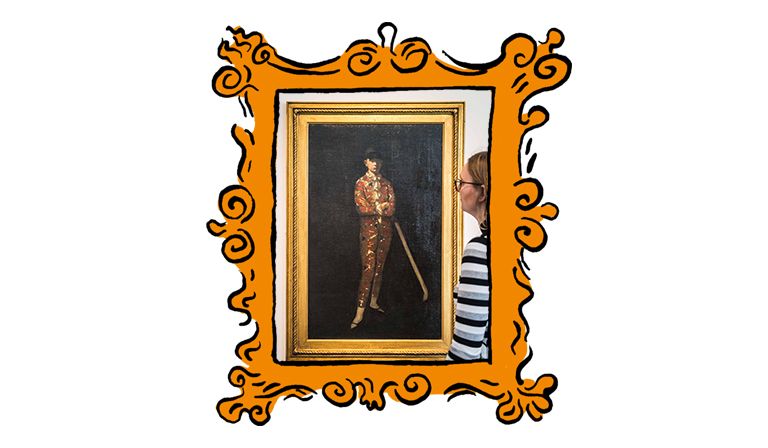A Bloomsbury Family, the 1907 portrait painted by William Orpen—one of the best-known society portraitists of the Edwardian era—is an image I think many will recognise. The family is posed in what looks to be a dining or breakfast room, the walls of which are painted an egg-yolk yellow. The pater familias, the artist William Nicholson—Orpen’s friend and peer, whose own skills as a portraitist were also deeply in demand—is in the foreground, elegantly reclining in a chair on one side of the scene, gazing straight in front of him, off to stage left. Three of his children sit at the table behind him: Nancy, who went on to become a painter and fabric designer; Tony, who died in the First World War at the age of only 21; and Ben, regarded today as one of Britain’s leading abstract artists. Their brother Christopher (“Kit”) stands in front of the table, on the opposite side of the picture to his father. He grew up to be a celebrated architect. Behind them all, right at the back of the room, her features shadowy and indistinct is William’s wife and the children’s mother, Mabel Pryde Nicholson, better known as “Prydie”.
At first glance, it might look like a traditionally posed Edwardian family portrait, Mabel’s stance suggestive of the wife and mother’s diminutive position in the household. But the truth of the matter was that she was an outspoken, rather rebellious woman of “vital personality,” as Ben poignantly remembered his mother in the 1950s, then more than four decades after her death. Mabel was also a skilled painter, every bit as talented as her husband, yet for many years she and her work have been all but forgotten. For most of the 20th century and on into the 21st, Mabel was relegated to a “footnote”—according to her biographer Lucy Davies, who also co-curated the show, with David Bomford—in the lives of the celebrated men around her, and her paintings omitted from the narrative of English modernism.
Mabel died in 1918, aged only 47, struck down by the influenza pandemic, itself something of a footnote to the bloody carnage of the First World War, perhaps hastening the obscuration of her legacy. Though not before her surviving children—Tony died only weeks after his mother—curated a memorial exhibition of her work, which was held in 1920. Then came silence. The current show, “Prydie: The Life and Art of Mabel Pryde Nicholson”, which is on at The Grange in Rottingdean, East Sussex, until 26th August, is the first exhibition of her extraordinary paintings in over a century.
The Grange is the perfect setting for this celebration. It was the Nicholsons’ home from 1909 to 1914, and it was here that Mabel returned with vigour to her easel, having put her brushes and palette (the latter, incidentally, is part of the display) aside while her children were in their infancies. She and William met at Hubert von Herkomer’s then world-famous art school in Bushey, Hertfordshire, where they were both students. They were married in 1893, and lived in Buckinghamshire, Oxfordshire, Hampstead and Bloomsbury, before arriving in East Sussex, from whence the family then moved to Wales. But it was in Rottingdean that Mabel painted some of her very best canvasses, and her most lucrative. Although she found her subjects in domestic scenes, and her own beloved children were the models to whom she turned to with regularity, she wasn’t a bored wife and mother messing around with a refined hobby. Kit in the Glass with Nancy and Sammy was just one of the portraits she exhibited at the impressive solo show she had at the Chenil Gallery on Chelsea’s King’s Road in 1912. It sold for £200—that’s nearly £20,000 in today’s money—a sum no mere amateur could command! Mabel used her earnings to commission the famous architect Edward Lutyens to build a studio in the grounds of The Grange, which she and her husband subsequently shared.
The paintings on display are wonderful. In the individual portraits, her children’s watchful, often surly faces loom out from heavy, dark backgrounds. Mabel clearly wasn’t afraid of negative space, nor the scrutiny of a spotlight-like stare. It’s a bold signature for an artist of her era; reminiscent of the work of Velázquez, but also strikingly modern. And especially effective in The Harlequin (c.1910), in which the gleaming silver and glowing deep red of the young boy’s costume leaps off the canvas, a loud flare of colour. She also has a keen eye for a layered, stage-like composition. The Grange (1911) shows Nancy and Kit inside the house. She is in the foreground, posed in a chair looking off to the left (a mirror image of her father in Orpen’s painting). Her brother, meanwhile, stands in the background, legs wide apart, hands boldly on hips, framed between an open door. While Family Group (c.1911) sees Tony, Nancy, Kit and the children’s nanny all dwarfed beneath a huge model ship.
Aptly, though, for an exhibition showcasing the work of an artist who languished forgotten for so long, the pictures that aren’t on display make just as much of an impact as those that are. Kit in the Glass with Nancy and Sammy is just one of a series of their mother’s paintings of which today we have only photographic evidence. The whereabouts of the originals is currently unknown. Lost, we hope, rather than destroyed.
Indeed, less than half of the possible 46 paintings that Mabel is thought to have completed are currently accounted for. As such, it’s not a large exhibition, but it is perfectly formed. In Mabel Nicholson (the latest volume in the Eiderdown Books’ “Modern Women Artists” series), Davies argues that her subject’s “finest pictures—the figures in Commedia dell’arte costume; the cryptic, beautifully muted portrait-interiors—all painted in the early 1900s, suggest an artist of such tensile strength that you have to wonder what she might have become.” This, of course, is the inevitable question asked of any artist who died young. Though reading Davies’s biography, it’s her portrait of Mabel as a mother that left the greatest impression on me. Mabel kept each and every letter sent by or about her children, and those who bore witness to the deep attention and affection that she lavished on all four attested that nothing was more important to her—certainly not her painting. Robert Graves, the poet and novelist who married Nancy in 1918, wrote that Mabel “chose to live obscurely,” uncomplainingly abandoning her art “to concentrate on the welfare of her children”.
Ben later recalled that, when seeing him off on the train to boarding school at the start of each term, Mabel would remark that “on no account must I come back top of my form as boys who did this never did anything afterwards, and doing something with one’s life afterwards was what mattered.” Reading these words now, in the context of Tony’s senselessly early death, is nothing short of heartbreaking. Could Mabel have borne the loss of her eldest child, poised as he was on the cusp of adulthood, the possibility of his life still stretching out in front of him?
A mother and a painter
Mabel Pryde Nicholson was an extraordinary artist made even more extraordinary by the fact she abandoned her art to concentrate on her children
August 15, 2024

The Artist's Daughter, Nancy, as a Harlequin © Paul Quezada-Neiman / Alamy









